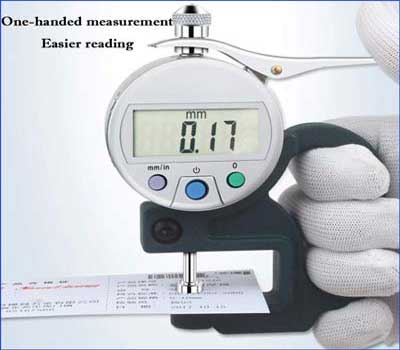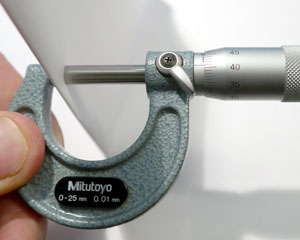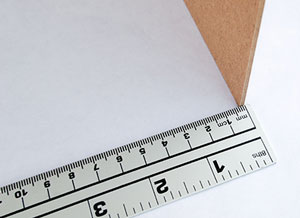
It may seem like an impossible thing to do, but it’s not. Measuring the thickness of the paper is totally possible, it doesn’t matter what you’re doing it for.
But it is not easy either. You’ll first need to have the ideal tools like a caliper, micrometer, or ruler. And then, you need sufficient sheets of paper so you can stack them up and measure accordingly.
Luckily, we’ll teach you how to measure the thickness of a paper with these tools. Whether it is a few sheets or an entire stack – you’ll have no problem.
Once you know the thickness, then you can start whatever project you want. But first, let’s explain these three methods in-depth:
1. Measuring Paper Thickness with a Caliper

The first method in our list would be using a caliper. Calipers deliver fantastic accuracy, making them even more useful. They look like a ruler, so they’re reasonably easy to use. However, they measure accurately as well, which makes them your best bet. Here’s what you need to do:
Set up the Caliper
You can find a caliper on most hardware stores as well as stationery shops and even online. If you already have one, then you won’t have to spend any money or time searching for it.
There are various types of calipers to consider. We recommend electronic models over manual ones for how easy they are to use. And they don’t lose much accuracy either. Otherwise, you may go for a manual caliper like a Vernier or Dial. Any model will work well enough.
Once you have the caliper, do this:
- Set it to millimeters or inches (if it is an electronic model). Otherwise, make sure it adjusts easily.
- Reset the caliper, so it gives a standard measurement. Do this by rotating the wheel on the piece and set it to 0.
- Then measure something around, like a pebble, a rock, a spoon, blade, or whatever. Finish by resetting it back to 0.
Setting it up by resetting the caliper is crucial for getting the most accurate result possible.
Measure the Stack
Now that you have the caliper ready, then it is time to rotate the wheel until it matches the stack or ream of paper. This will give you the measurement.
Here’s how to do so:
- First, look for a ream or stack of paper. You don’t need to measure more than 50-100 pages. This will help you calculate the measurements later.
- Adjust the caliper to match the thickness of the ream or stack you want to measure. Rotate so the jaws open to fit the ream of paper inside.
- The jaws should grab the paper tightly. But not too much, or you may end up tearing or crushing it down, which messes up the measurement.
- If you have an electronic caliper, then you’ll receive the measurement on display. But if you have a manual one (Vernier or Dial), then you’ll have to look for what the dial marks in the scale.
It is super important to do this with care. The more accurately you place the caliper on the stack of paper, the more accurate the final result will be.
Get the Final Measurement
Once you measure the stack of paper, then you will get something like 1 or 2 inches in the caliper. Having this will help you calculate the total thickness of every individual page.
Here’s how to make the final measurement:
- If you measured about 100 pages, you probably get about 1 inch in the caliper. You will need to divide the 1 inch for the number of sheets in the stack.
- Let’s say you measure a 50-page ream. If the total measurement is 1 inch, then you need to divide that 1 inch by 50. That would give 0.02.
Once you have the 0.02 inches per page, then you know the thickness of the paper. You can now proceed to do whatever you want with it.
2. Measuring Paper Thickness with a Micrometer

The second and most accurate way to measure paper thickness is to use a micrometer. This is at least twice as accurate as a standard caliper, so it is probably the best option you can go for.
It works just like a caliper – yet you need to be a little more careful when measuring as it is way more accurate. At the same time, a micrometer lets you measure way fewer sheets – which is an excellent advantage for extra accuracy. Here’s how to proceed:
Set up the Micrometer
If you haven’t heard of a micrometer, then you’re probably confused about what it is. In short, we can say it is a caliper for micro-measurements. That means you get the same purpose, but for smaller stuff and with greater accuracy.
There aren’t many types of micrometer. You will only need to pick between those that use inches and the ones that use millimeters. Same as calipers, they’re usually sold in hardware and stationery shops.
Set up the micrometer following this:
- Make sure you can open and close the jaws of the micrometer. Do this by moving the dial, so the measuring shaft moves up and down accordingly.
- Try to look for the shaft and see that it gives accurate measurements. Try measuring anything around so you can find out whether it works well or not. At the same time, make sure it is readable.
After setting up the micrometer and making sure it works, you are ready to start measuring the paper.
Measure the Paper
Once you have a micrometer, it is time to measure the paper. This is not an easy thing to do, as micrometers are extra-accurate, so you will have to be as careful as possible.
Here’s how to measure with a micrometer:
- Start by considering whether you want to measure a few pages (20 pages will suffice), or an entire stack/ream (from 100 to 200 pages). You can measure both ways with a micrometer.
- Then proceed by setting up the micrometer at the ideal thickness of the paper. Move the thimble/dial accordingly, so the claws open to fit the paper. You will see how the shaft moves depending on how much you open the jaws.
- If the stack is small (20 pages or so), then you will probably adjust the jaws accordingly. This usually starts at about 0.1 inches and goes on from there. Remember that these tools can go really low in inches, so you need to place the micrometer as accurately as possible.
- Then, get the marks on the shaft gauge or sleeve. This is a small set of lines that usually go from 0 to 25. And this measure should go perfectly with the lines on the tube shaft, not the same for the first measurement, but the ones on the other face.
To explain this, you will get the first measurement by adjusting the jaws to the paper. This starts at 0.1-inches. Then you’ll get the second by looking at which lines on the gauge fit well with the opposite lines on the shaft tube. These usually go from 0 to 11 – with 1 meaning 0.005 inches.
The lines/marks will tell you how thick the paper is. Write or type these two measurements, so you don’t lose it.
Calculate the Thickness
You have two measurements now. The one given from the shaft starts at about 0.1-inches. Then you have the measurement from the gauge with the other face of the gauge, which goes from 0 to 11.
So, what can you do with these measurements? Follow these steps:
- Let’s say the first measurement ended up in the number 1 (0.1-inches). Then the second (gauge with shaft) gave you 5 (0.005-inches). Well, now you need to add them up. This should give you a total thickness of about 0.105 inches.
- If you measured a sheet alone, then this would be the final thickness. But if you measured an entire stack, then you need to dive that number by the number of sheets. For example: 0.105 / 20 = 0.00525 per sheet.
As you can see, this process may take a few more time and effort than you think. But it is the most accurate out there – so we recommend it if you need the exact measure.
3. Measuring Paper Thickness with a Ruler

Let’s say you don’t have a micrometer or a caliper around. Then the obvious thing to use would be a ruler. This is the easiest yet less accurate way to measure this. So, we recommend doing this only as long as you can’t use any of the other two tools. Here’s how to measure with a ruler:
Stack up Sheets
Because rulers are less accurate than both calipers and micrometers, you’ll need to stack at least 1-inch thick to get an ideal measurement. If you can get an unused ream of paper, that will make it easier – because they’re already counted and put together tightly.
Here’s how to stack up the sheets:
- Make sure they’re all of the same type of paper. You won’t like to measure thick with thin paper, as that will give you an inaccurate result.
- Then count at least 100 sheets of paper and put them together. If you’re measuring really thick paper, then you can use 50 or less. Make sure it gets at least to an inch. Organize the whole stack, so not even a single sheet bends or moves out. It should be as firm and flat as possible.
- If you have a ream paper, try to not disrupt it. For wrapped reams, try to be as careful as possible when taking the wrap off. Make sure to know how many sheets there are in the ream as well.
You can use as many sheets of paper as you want. But remember that rulers are less accurate – so knowing the number of sheets is vital so you can calculate easily.
Measure the Stack/Ream
With the stack or ream ready, you can start measuring to see the total thickness.
Here’s how:
- Make sure the whole stack is organized and firm. Newspaper sheets and other types of paper can be challenging to organize. For that, place something heavy on the top – such as a book, or something that won’t damage the paper. This will pin it down. Otherwise, you can use your hand.
- Then move the ream/stack to the border of a table until one of the edges/corners floats. Here, you should use the ruler to measure the total thickness.
Depending on the type of paper, this should give you a measurement that goes over 1 inch if you put together more than 100 pages.
Calculate the Thickness
With the total measurement of the stack, then you’re ready to calculate the entire thickness of each sheet.
This is pretty easy – you just need to:
- Divide the total measurement of the stack/ream of paper by the number of sheets. For example: 2 inches/100 pages = 0.01-inches sheets.
- In case you measured the stack, and it gave you less than an inch, then you need to do the same. For example: 0.5-inches/100 sheets = 0.005-inches per sheet.
We do a deep dive into this site review inspiration for more information about different types of paper, sketchbooks, cardstock and arts-related article.
Start Measuring Thickness of Paper Now!
As you can see, measuring the thickness of paper takes more time and effort than it seems. But with the right methods, it shouldn’t be much of a problem.
Once you learn how to measure the thickness of paper, then you can start any of your projects without worries and with greater precision. So follow this guide and start measuring.
Read Our Other Crafting Article:
